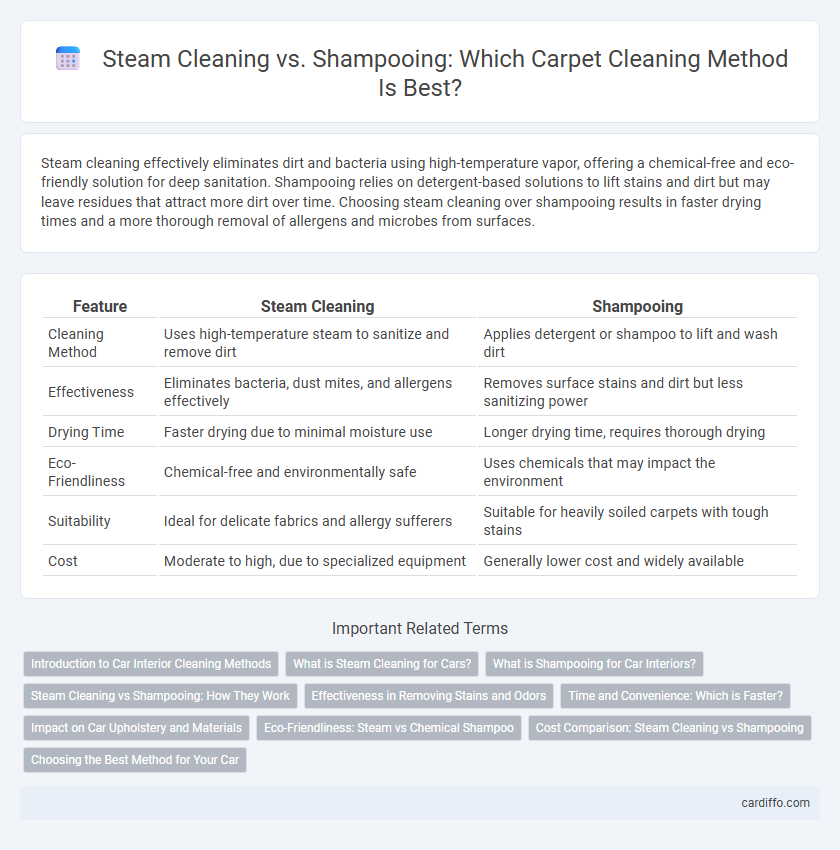Steam cleaning effectively eliminates dirt and bacteria using high-temperature vapor, offering a chemical-free and eco-friendly solution for deep sanitation. Shampooing relies on detergent-based solutions to lift stains and dirt but may leave residues that attract more dirt over time. Choosing steam cleaning over shampooing results in faster drying times and a more thorough removal of allergens and microbes from surfaces.
Table of Comparison
| Feature | Steam Cleaning | Shampooing |
|---|---|---|
| Cleaning Method | Uses high-temperature steam to sanitize and remove dirt | Applies detergent or shampoo to lift and wash dirt |
| Effectiveness | Eliminates bacteria, dust mites, and allergens effectively | Removes surface stains and dirt but less sanitizing power |
| Drying Time | Faster drying due to minimal moisture use | Longer drying time, requires thorough drying |
| Eco-Friendliness | Chemical-free and environmentally safe | Uses chemicals that may impact the environment |
| Suitability | Ideal for delicate fabrics and allergy sufferers | Suitable for heavily soiled carpets with tough stains |
| Cost | Moderate to high, due to specialized equipment | Generally lower cost and widely available |
Introduction to Car Interior Cleaning Methods
Steam cleaning uses high-temperature vapor to effectively sanitize car interiors by killing bacteria and loosening dirt without harsh chemicals. Shampooing involves applying foam-based cleaners that penetrate fabric surfaces to remove stains and odors through agitation and extraction. Both methods enhance cleanliness, but steam cleaning offers deeper disinfection while shampooing excels at fabric stain removal.
What is Steam Cleaning for Cars?
Steam cleaning for cars utilizes high-temperature steam to remove dirt, grease, and bacteria from vehicle surfaces without harsh chemicals, ensuring a deep and eco-friendly clean. This method effectively sanitizes upholstery, carpets, and hard-to-reach areas by loosening grime and killing germs through intense heat. Steam cleaning prolongs the lifespan of car interiors while minimizing water usage compared to traditional shampooing techniques.
What is Shampooing for Car Interiors?
Shampooing for car interiors involves applying a specialized foaming detergent to fabric or carpet surfaces, which is then agitated to lift dirt, stains, and grime effectively. This method penetrates deeply into fibers, breaking down embedded contaminants and odors to restore the upholstery's cleanliness and freshness. Unlike steam cleaning, shampooing relies on chemical cleaning agents combined with mechanical action to achieve a thorough interior cleanse.
Steam Cleaning vs Shampooing: How They Work
Steam cleaning utilizes high-temperature steam to penetrate fabric fibers, effectively loosening dirt, grease, and bacteria without the need for harsh chemicals. Shampooing involves applying a foamy detergent solution to surfaces, which is then scrubbed and rinsed, often leaving residues that require thorough drying. Steam cleaning offers a chemical-free, quick-drying alternative, while shampooing relies more on soap-based agents and water extraction.
Effectiveness in Removing Stains and Odors
Steam cleaning uses high-temperature vapor to effectively break down stubborn stains and eliminate deep-seated odors by killing bacteria and mold spores. Shampooing relies on detergents and water to lift surface dirt and grime, but it may leave residues that trap odors and require longer drying times. For intense stain removal and odor neutralization, steam cleaning generally offers superior performance and faster results.
Time and Convenience: Which is Faster?
Steam cleaning typically requires less time than shampooing because it involves a quick application of high-temperature steam that lifts dirt and kills bacteria without extensive drying periods. Shampooing often demands more time due to the need for scrubbing, rinsing, and prolonged drying to prevent mold and mildew. For busy households or commercial spaces aiming for efficient cleaning, steam cleaning offers a faster and more convenient solution.
Impact on Car Upholstery and Materials
Steam cleaning uses high-temperature vapor to sanitize car upholstery, effectively removing dirt and killing bacteria without over-saturating materials, preserving fabric integrity and preventing mold growth. Shampooing involves applying detergent and water, which can leave residues and moisture that risk weakening fabric fibers and causing unpleasant odors over time. For delicate materials like leather or suede, steam cleaning offers a gentler, low-moisture alternative that maintains texture and appearance more effectively than shampooing.
Eco-Friendliness: Steam vs Chemical Shampoo
Steam cleaning uses high-temperature vapor to sanitize surfaces without the need for chemical detergents, making it an eco-friendly alternative that reduces water consumption and chemical runoff. In contrast, shampooing often relies on synthetic chemicals that can harm aquatic ecosystems and contribute to indoor air pollution. Choosing steam cleaning supports sustainable cleaning practices by minimizing environmental impact and promoting healthier indoor environments.
Cost Comparison: Steam Cleaning vs Shampooing
Steam cleaning typically incurs higher upfront equipment costs but offers long-term savings through reduced chemical use and maintenance. Shampooing involves lower initial expenses but often requires frequent treatments, increasing overall cost over time. Evaluating factors such as frequency, labor, and product expenses highlights steam cleaning as a more cost-effective solution for extensive or regular deep cleaning needs.
Choosing the Best Method for Your Car
Steam cleaning uses high-temperature vapor to sanitize and remove dirt from car interiors, offering a chemical-free, eco-friendly approach that effectively kills bacteria and allergens. Shampooing involves applying a foamy detergent to fabric surfaces, penetrating deep stains and residues but may require longer drying times and risk of moisture damage. Selecting the best method depends on the car's material, level of soiling, and desired drying speed, with steam cleaning favored for delicate upholstery and shampooing for heavily stained carpets.
Steam Cleaning vs Shampooing Infographic

 cardiffo.com
cardiffo.com